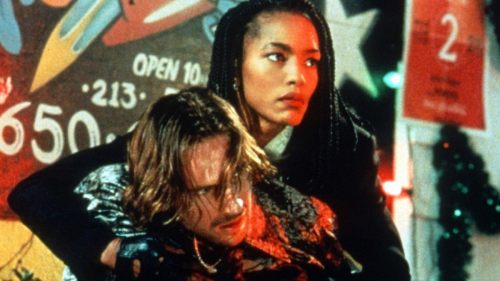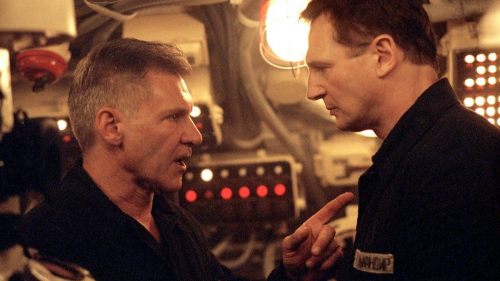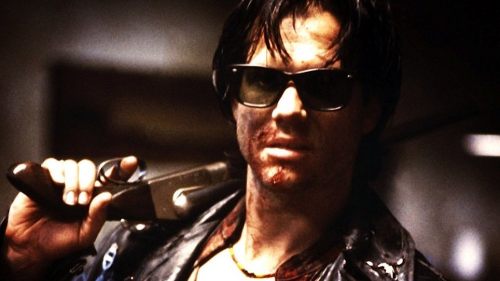DETROIT Review: Torture Studies In Black & White
When Kathryn Bigelow and Mark Boal made Zero Dark Thirty (’14), their depiction of torture was so detailed that the production was investigated by the Senate Intelligence Committee, to ensure that the creators had no “inappropriate contact” with CIA operatives involved in Osama Bin Laden’s assassination. That morally ambiguous fictional profile of the men and women hunting criminals partially responsible for the September 11 attacks was remarkably thorough, and never cast any moral judgement on those employing such brutal interrogation tactics, leading many critics (including Senator John McCain) to accuse Bigelow and Boal of condoning such practices during a time of war, as the intel gathered led to the eventual demise of the globe’s greatest terrorist. Bigelow contested that depiction did not necessarily equate to endorsement during interviews, as she was simply fascinated by the “ingenious detective work” that concluded in the Al-Qaeda leader’s murder at the hands of SEAL Team Six.
Bigelow and Boal’s latest is Detroit – a natural docudrama extension of Zero Dark Thirty’s torture studies. Taking place amidst the titular metropolis’ race riots in the Summer of ’67, their movie is a Molotov cocktail of didactic violence, utilizing the civil disturbance as a backdrop to detail the infamous Algiers Motel incident, which saw a gaggle of black men and two white women dehumanized at the hands of three white police officers and a National Guardsman. Make no mistake, Detroit is a horror movie masquerading as historical chronicle, where systemic racism is the monster, terrorizing human beings in the name of protecting and serving. Bigelow and Boal have crafted a motion picture that’s positively furious, presenting police brutality with the unflinching eye of a body camera before such devices even existed. Though choppy in narrative construction (Boal’s screenplay feeling forcibly fractured into three defined acts), the central set piece that makes up the film’s second narrative movement is like a home invasion nightmare, where those causing the chaos are granted near unchecked power thanks to their positions of authority.
Following a kaleidoscopic montage of crude mural animation – describing black migration (to a city that offered blue collar jobs thanks to a booming auto industry), the ensuing “white flight”, and subsequent segregation of the city’s neighborhoods (which were unnaturally policed by a 93% Caucasian force) –Detroit zeroes in on the unrest’s inciting incident. Sunday, July 23, 1967: police raid an unlicensed drinking club in the 12th Street office of the United Community League for Civic Action. It’s nothing more than a late-night homecoming party for a local Vietnam vet, and one of the department’s few black liaisons (Chris Chalk) does his due diligence to try and break up the shindig with dignity, but a gate lock forces those attending the soiree to be marched out front. This public display of white men raining on an obviously harmless parade causes the neighborhood to gather ‘round and start shouting. Soon after, a bottle a thrown. Then a brick. Before long, looters are crashing through store fronts, and the National Guard are called in by Governor Romney (in archival footage) to try and quell this perceived racial rebellion.
Presenting it all with handheld, fly on the wall pseudo-realism, Bigelow’s Hurt Locker (’08) cinematographer Barry Ackroyd brings the same “you are there” immediacy he did to Paul Greengrass’ United 93 (’06) and Captain Philips (’13). We’re down in the crowd, as a community leader tries to calm his people from the top of a car, and navigating the crammed hallways of a precinct packed with black arrests. We’re backstage with local R&B crooners The Dramatics as they anxiously await their time behind the microphone, knowing a Motown A&R man is seated somewhere in the audience. Immersion is key, as the period details dressing up Boston to look like the Motor City are never overly ostentatious or gaudy. Ackroyd’s ever-shifting mise en scène connects the racial turmoil to our tumultuous present, the modernity of execution bringing an almost anachronistic tone to the proceedings, as James Newton Howard’s subtly unnerving score drones on the low end of the soundtrack.
Above all else, Bigelow will always be an action director. Our primary introduction to Officer Krauss (Will Poulter) is a foot chase – leaping from a squad car in hot pursuit of a looter after commenting to his partners (Jack Reynor and Ben O’Toole) how their force has failed “these people”. However, his empathy is short-lived as he draws his shotgun and puts a blast of buck shot into a black thief’s back. The imagery is no doubt a subversion of a similar chase she staged (albeit with much more anti-realist aplomb) in her surfing bank robber shoot ‘em up masterwork, Point Break (’91). Here, there’s no love lost between the patrolman and his quarry, as the man who simply stole two bags of groceries limps, falls, and then bleeds out under a nearby automobile. While the glorification of “cops and robbers” is notably absent, Bigelow’s adrenaline addiction is still present and accounted for, as she can’t help but indulge her old genre days at least a little.
It’s truly difficult to overstate how committed and brilliant Will Poulter is in Detroit. Sporting the most punchable face this side of Paul Dano, the English actor channels an ingrained racism that seems to expand in his belly over the course of Detroit’s 143-minute runtime. Oddly articulate, and showcasing a rubbery array of facial expressions, his reactions to the increasingly bizarre and twisted acts of racial violence he attempts to justify with his profession are appalling. Perhaps more impressive than the wanton, seething prejudice Poulter injects into this alleged peacekeeper is the inflated sense privilege Krauss has a keen self-awareness of. Even after he’s informed that a homicide detective is going to seek murder charges for the aforementioned shooting, the beat-walker pompously adjusts his cap and waves off the potential indictment simply because he knows he’s fucking white. This is the sort of turn that catapults a career into the upper stratosphere of stardom, and if there’s any justice in this world, we’ll be remembering Poulter once Oscar Season rolls around.
Bigelow’s approach to generating suspense mirrors Hitchcock’s famous speech regarding letting the audience know about the anarchist’s bomb. Once we’re inside the Algiers Motel, we’re treated to a street level view of hustlers like Carl Cooper (Jason Mitchell), who treats Dramatics crooner Larry Reed (Algee Smith) to an elementary lesson in how “being black is like having a gun pointed at your face”. But the same starter pistol he uses to illustrate a point with his friend Lee (Peyton Smith) is utilized to play a joke on nearby cops, when he unloads a clip of blanks that makes the men in uniform feel like they’re under fire from a sniper. The gun is fake, but the fleet of officers and reserves (led by Krauss and his flunkies) are soon kicking the door down and lining everyone inside the Algiers annex against the wall. Barking like rabid frat boys hazing pledges, and incensed to find two pretty young white women (Hannah Murray and Kaitlyn Dever) amongst these “animals”, Krauss threatens to kill them all if they don’t give up the shooter. We know that this person doesn’t exist, but the cops don’t, which leads to an escalating display of heinous torture known as “the death game”, where those in charge take victims one by one into adjacent rooms and simulate their individual murders.
The claustrophobia we experience during the Algiers section is enough to induce a full-blown panic attack, as screams penetrate the walls and echo through the halls (the sound design is outright oppressive). Watching it all with wide, terrified eyes is Melvin Dismukes (John Boyega) – a mild mannered security guard who was manning his post at a grocery store across the street from Warrant Officer Roberts (Austin Hebert), both of whom assist in this civil atrocity. Dismukes’ view on blackness is one of survival, not resistance, which earns him an “Uncle Tom” label from his peers. For Melvin, staying out of the white man’s way and keeping your mouth shut is the best way to make it through this unfair era. Dismukes is the closest Detroit ever comes to offering up an audience identification character amidst these savage monsters and their teary-eyed victims, as he slowly comes to the realization that there may not be a gun in any of the Algiers’ rooms (at least not one that belongs to these kids), but that’s not going to stop the beasts in blue from raining true death down on their heads. When combined with the cool stoicism of Greene (Anthony Mackie) – another ‘Nam veteran whose first instinct is compliance and service in the name of retained dignity – Detroit offers up contrasting theses regarding individuals’ approaches to racial discrimination. You can either fight back, or do your best to live whilst holding your head high in a country that looks down on your skin.
One of the wiser decisions Detroit makes is never forgetting that these awful events transpired in a hotbed of musical talent. Motown was experiencing its peak during the '60s – owning seventy-nine Billboard Top Ten records between ’60 – ’69. Bigelow and Boal make sure to capture instances of tuneful splendor, such as when Larry sings in front of an evacuated auditorium, and later marvels at the quaint miracle that is a neighborhood gospel choir. Following the events of the ’67 riots, Motown Records founder Berry Gordy Jr. began moving the landmark label away from its namesake and to the sunny entertainment capital of Los Angeles (a migration that was completed in ’72). So, not only is Detroit chronicling a key occurrence in racial history, it’s also profiling a moment where one of the greatest artistic crossover success stories for black musicians fled for its life. These are the days when the music died in Detroit, and this underlying tragedy is as heartbreaking as any of the racial injustices on display.
As powerful as Detroit is as a piece of expertly crafted horror filmmaking, it’s also difficult not to ponder who exactly Bigelow and Boal’s picture is for. Certainly not black audience members, as the terrors of organized hate their movie works to unveil (right down to the marketing tagline “It’s time we knew”) are already common knowledge to anyone who’s lived under the threat of systemic racism and police brutality since birth. At the same time, Detroit is by no means an entertaining movie (at least in the traditional sense). Impeccably executed, and filled with thrilling moments; but also upsetting in a way that leaves viewers desiring to never revisit its shocking images again. For all the no nonsense depictions of war on terror savagery perpetrated by the American Intelligence Community, Zero Dark Thirty at least offered up a fetishistic procedural that acted as a diverting counterbalance to numerous grueling walks into dark rooms decorated with emaciated, waterboarded bodies. Even the wonky courtroom coda to Detroit (which is where Boal’s screenplay falters the most) delivers little to no hope, sending viewers out of auditoriums and into a modern age where black men like Oscar Grant and Eric Garner had their lives thoughtlessly snatched away by local patrolmen.
While it’s not Bigelow and Boal’s responsibility to justify their art’s existence, these types of questions are certainly fair game once the end credits roll. Is Detroit sending its target audience anything beyond a grueling warning that “then wasn’t so different than now”? In Brian De Palma’s Godardian satire, Hi, Mom! (’70), there’s a section titled Be Black Baby, where a group of African American radicals invite a group of WASPs into their performance art arena, slather them in blackface, and then terrorize them while donning whiteface. Played out entirely in grainy black and white with natural sound, two of the white participants are raped, and even when an actor playing a police officer (Robert De Niro) intervenes, he merely arrests those in blackface simply because of their new color. Detroit seems to be aiming for a similar goal – simulating the cruelty black folks face at the hands of white oppressors, so that their Caucasian neighbors may see through their eyes, if only for two and a half harrowing hours.
Only Bigelow and Boal’s latest isn’t satire. It doesn’t end with the participants laughing the ordeal off afterward and making cocktail hour comments regarding how enlightening they found the “exhibit”. This is a key piece of American Civil Rights history that loosely dramatizes what few firsthand accounts from the incident remain. Of course, the intention behind Detroit’s creation seems to be pure, yet one suspects certain African American audience members are going to (rightfully) be put off by two white artists co-opting their people’s experiences in the name of crafting a grotesque teaching tool. It’s a curious case of a movie being genuinely great, yet still not really being for anyone in particular. That said, Bigelow is one of the finest filmmakers to ever step foot behind a camera, and has earned the right to tell any tale she desires. While Detroit may not be as airtight in terms of storytelling tradecraft as Zero Dark Thirty, it’s no doubt another staggering entry into one of the most fascinating filmographies ever assembled.



